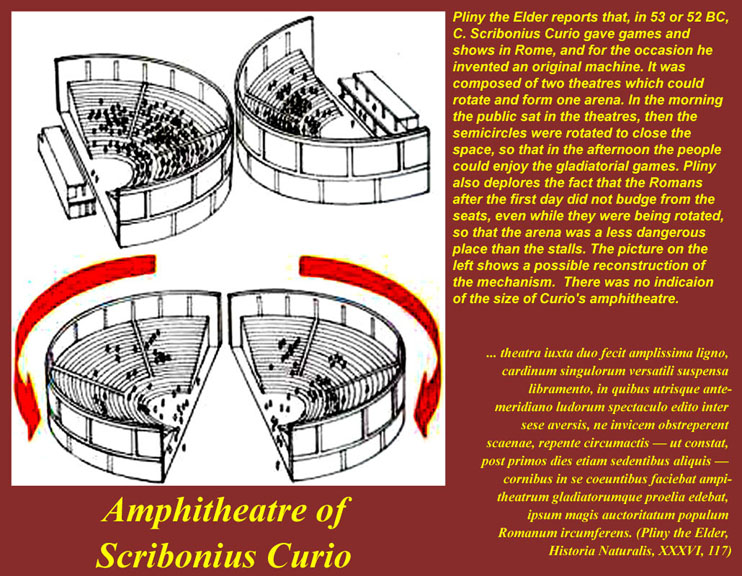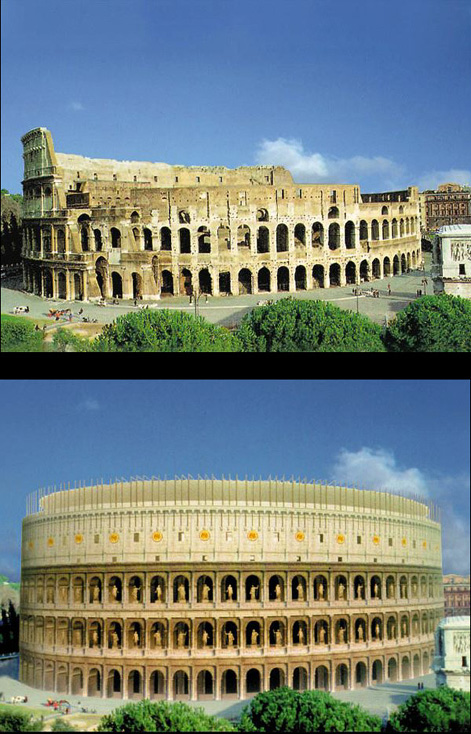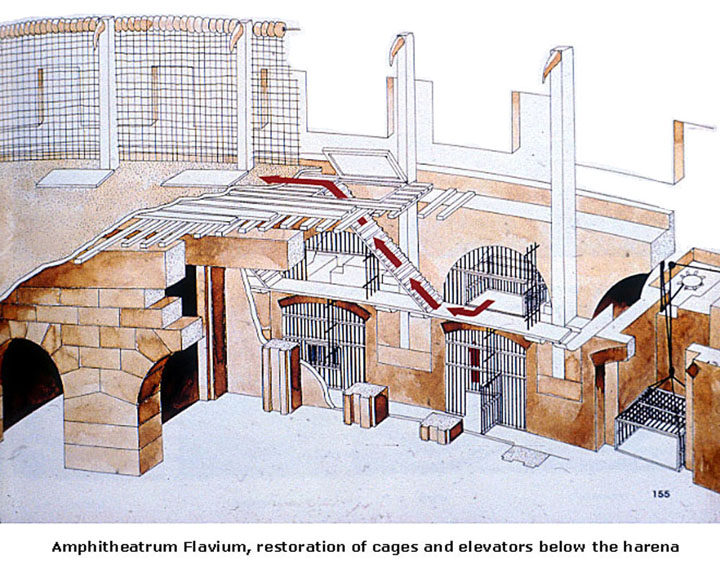

The Theater of C. Scribonius Curio;
An Investigation of Experimental Wooden Spectator Seating Systems in Late Republican Rome.
Paloma Schulz
A unique experiment in hybrid architectural design took place in 50 BC when C. Scribonius Curio commissioned an amphitheater/theater consisting of two wooden halves that revolved on massive pivots sunken into the ground. When facing each other, the two sides would form an enclosed amphitheater allowing spectators a complete panorama of the arena and of each other. Pivoting away from one another, the two halves could be made to form twin theaters allowing two separate events to take place simultaneously. Pliny describes the edifice:
("He built close to each other two quite ample wooden theaters, each supported and balanced on a revolving pivot. In the morning, a performance of a play was given in both of them and they faced in opposite directions so that the two casts would not drown out each other's words. Then all of a sudden the theaters would revolve (and it is agreed that after the first few days they did so with some of the spectators actually remaining in their seats), revolving into position the corners would meet, and thus Curio could also provide an amphitheater in which he produced fights between gladiators.")(1)
The durability of such a complex wooden structure through two years of almost constant use seems to indicate a very high level of architectural know-how and building expertise. How is it that by 50 BC Roman architects had acquired such skill at constructing wooden seating structures? In this paper I hope to show that by the late republican period, Roman architects had a rich and complex tradition of designing and building temporary seating for a variety of events and that these constructions represent a typically Roman attitude towards architectural form. In fact, the stone structures commonly associated with Roman amphitheaters were a later and essentially non-Roman (Greek influenced) development -- a development brought about by economic and urbanistic limitations: it was much more expensive to build, deconstruct, and then rebuild temporary seating thirty to fifty times a year in the Roman Forum -- the most prestigious and holy spot in Rome -- than it was to build one fixed stone edifice on the outskirts of town. It is well known that by 50 BC, building-quality timber was a very precious commodity in central Italy. One hundred and fifty years of civil strife, as well as clearing of timber for enormous farms and vineyards, meant that good quality timber already had to be shipped from abroad. Stone, however, was abundant around Rome. Why then would Roman architects persist in building these complex outdoor wooden structures? What relationship did the temporary nature of these constructions have with the kinds of events that took place in them? What role did the political and religious needs of the spectators have in this architectural phenomena? I will attempt to answer these questions by showing that the amphitheater in its very nature was a temporary and mobile construction and that its transitory state epitomized Roman ideas of strength, efficiency, and practicality. The materials and construction styles of these late republican amphitheaters were bound up in the identity of Rome itself.
I -- A Short History of the Development of the Amphitheater Type as well as some Definitions of Important Terms.
Originally, the amphitheater (3) type was specially related to gladiatorial combat. This combat -- first between prisoners of war but evolving later to include a semi-professional gladiatorial class -- began as munus mortis, an offering or duty paid to the manes (the shades or spirits of dead Roman chieftains). Adopted from Etruscan or Samnite funeral sacrifices, the first recorded gladiatorial games were given by the sons of Junius Brutus in 264 BC to the shade of their dead father. The combat was based on the idea that the recently deceased were in a state of extreme turmoil, angry at the world they had left and distraught by their new surroundings; only fighting and additional death could pacify them. Three pairs fought in this first munus. In 174 BC seventy-four men (Etruscan prisoners of war from the recent Roman victory over the Tarquin) fought for three days in honor of the dead father of Titus Flaminius. By 150 BC these combats took place exclusively in the Roman Forum, the historical meeting place for Roman citizens since the very founding of the city in 753 BC by Romulus and Remus. This oblong open area fringed by a row of columns was the city's holiest, most sacred ground and was strongly associated with spirits of dead ancestors and the cult of the dead. Every Roman from the beginning had walked and lounged and conversed on this small oval piece of land that was designated by the shape of the Curtian lake which formed during the winters in the hollow between the hills of the Palatine and Quirinal. The Forum was a flexible, multipurpose space that always remained open; any event that took place there was by nature temporary. For the munus combats, wooden seats were installed around the perimeter -- just inside the columns -- forming a rough oval shape, and were dismantled immediately afterwards. Only incidental accounts exist of this scheme: Propertius said:
(" you are not to dress up and walk about in Pompey's colonnade, or when the sand is strewn for games in the Forum.")(4)
Kate Welch (5) and J.C. Golvin (6) argue successfully that the canonical elliptical form of the amphitheater type was dictated by the oblong shape of the Forum Romanum. Vitruvius tells us that from the very beginning the lay out of the wooden seating for events in the Forum was oval, following the shape of the perimeter.(7) The prestigious location of these structures in the Forum, the epicenter of Roman life, caused them to become the model for spectator structures all over the Roman world, and to inform the shape and style of the earliest stone amphitheaters in colonial cities like Pompeii (a Sullan colony of 80 BC), and even in locations as far flung as Carmona in Spain, Antioch in Syria, and Corinth in Greece. The construction of an amphitheater (the loyal reproduction, the oval shape and functional appearance) became the official method for applying a Roman architectural stamp on non-Roman communities. Vitruvius describes the ideal form of the Roman town:
("The Greeks lay out their town squares in the form of a square with wide double porticoes ... but in the cities of Italy the same method cannot be followed for the reason that it is a custom handed down from our ancestors that gladiatorial shows as offerings to the dead should be given in the Forum. Therefore, let the intercoluminations around the show place (spectacula (8)) be rather wide; round about in the colonnades put the bankers' offices; and have balconies on the upper floors (maeniana superiora (9)) properly arranged so as to be convenient and so as to bring in some revenue. The dimensions of the Forum ought to be adjusted to the audience lest the space be to cramped for use, or else, owing to a scanty attendance, the Forum should seem to large. The proportion of the Forum should be 3:2, length to width. Its shape will then be oblong and its ground plan conveniently suited to the conditions of the shows.")(10)
("but Maenius took the right for himself of a single column, above which he extended a roof out of sliding planks [probably a cantilevered balcony] from where he himself and his descendants could watch gladiatorial games, which even then were given in the Forum.") (11)
Plutarch records that Gracchus had these seats removed immediately so that the plebs could watch the show without paying -- suggesting that the Forum was in a constant state of flux, one moment seating, the next none. During the Republic the seating was occupied in promiscue (all mixed up) but in the early empire a series of laws, lex julia theatralis, rigidly segregated the audience into different groups by class, race and gender. Suetonius tells us that senators and vestal virgins got front row seats, knights sat above, then came male Roman citizens of the middle classes, and finally women and slaves at the top.(14) This hierarchical division was also achieved on a horizontal level with the cunei (wedges) closest to the minor axis of the oval containing the most important people as they afforded the best view. Tesserae (tickets to the arena show) have been found in archeological excavations and date from the republican era as early as the reign of Sulla. Vela (awnings to protect the spectators from the sun) were built on several occasions over the whole Forum as early as 46 BC and elaborate hypogia (subterranean passages to transport personnel and combatants in and out of the Forum) had been excavated and functioned as a sort of backstage.
Even with these new amenities, the temporary seating structure of the Roman Forum during a gladiatorial show was an uncomfortable and dangerous place, where people sat in the same position sometimes for days on end, exposed to the weather, their neighbors, and the authorities. The Roman amphitheater was a boisterous, disorderly, and volatile public assembly. Major, bloody battles like the one that took place between the Nucerian and Pompeian spectators and their sympathizers in the amphitheater at Pompeii in 59 BC(15) were a normal and frequent occurrence in Rome as well. The audience came to be seen and heard, to act and interact; their performance was not a simple reaction but a counterpoint to the events taking place on the sand. Suetonius tells of a certain Esius Proculus who was noticed by the Emperor Caligula while sitting in the stands around the Forum because of his striking stature and physique.(16) He was dragged from his seat and matched with a gladiator in the arena. When by some miracle he won the first bout, he was compelled to face still another opponent, only to be killed. The crowds were delighted. This unpredictability was a key factor in the design and construction of seating systems in the late republic and early empire. Constant change and flexibility in the design of the structures and in the dates and times of the construction and deconstruction allowed the wealthy sponsors of the combats to control the populace, diffuse political strife, and influence opinion.
II -- The Paradox of Curio's Amphitheater: High Tech Verses Perceived Austerity.
Caius Scribonius Curio, a childhood friend of Julius Caesar, had a taste for extravagance and luxury which, by the year 51 BC, amounted to almost thirty million dollars of debt, in present-day figures, an astronomical amount for someone of his youth. But the vastness of this debt shows how wealthy private citizens of Rome had become. Caesar, occupied with his army in Gaul, needed someone to look after his interests in Rome. He paid Curio's debts and in return Curio cautiously began to promote Caesar's interests in the senate. With his newfound solvency, Curio began his project for the pivoting amphitheater. The gladiatorial combats it would offer and the uniqueness of the structure itself would generate enormous popularity and goodwill from the people of Rome towards his new sponsor, Julius Caesar. Thanks to the conquests of Caesar, Pompey, and Marc Antony, military and navel architecture had achieved a new level of sophistication and technological advancement. During the conquest of Gaul, Caesar had built great wooden forts up and down the frontier, as well as powerful siege engines and catapults -- all built of local timber. The army architects had learned to fell the best trees for particular uses and had perfected the arts of joinery and milling using special axes and mechanical drills. Gaul was a great resource for lumber, and boards of great length and straightness were being cut and exported to Rome. Naval architecture was also experiencing a technological surge: boats of extreme speed and size were being built in the shipyards, they carried masts and sails that rotated with the wind as well as great winches to pull them up and down. Undoubtedly, this boom in military architecture, with engineers focused on speed, mobility, and flexibility, had an impact on urban projects in Rome; there would have been no shortage of military engineers to figure out Curio's pivot mechanism. But the experimental state of wooden seating structures also had unfortunate consequences.The amphitheater of Atilius at Fidena was apparently built too big and too quickly and on an uneven foundation. In 27 BC, it collapsed under the weight of an unusually large crowd, killing tens of thousands of people:
("In the consulate of Marcus Licinius and Lucius Calpurnius the casualties of some great war was equaled by an unexpected disaster. It began and ended in a moment. A certain Atilius, of the freedman class, who had begun an amphitheater at Fidena, in order to give a gladiatorial show, failed both to lay the foundation in solid ground and to secure the fastenings of the wooden structure above... the gravity of the catastrophe, as the unwieldy fabric was packed with people when it collapsed, breaking inward or sagging outward, and precipitating and burying a vast crowd of human beings, intent on the spectacle or just standing around...fifty thousand persons were maimed or crushed to death in the disaster.")(17)
----------------------------------------------
Notes
1. C. Plinius Secundus, Naturalis Historiae, 36.24, 36117.
2. Cicero, Ad Familiares., 8.2.1.
3. Amphi, the Greek word for both, amphitheater means a space in which the spectators can see both sides.
4.Sextus Aurelius Propertius, 4.8.75-76.
5. Kate Welch, Roman Amphitheaters (New York: Institute of Fine Art, N.Y.U. Press, 1994).
6. J.C.Golvin, L'Amphitéâtre romain; Essai sur la théorisation de sa forme et ses fonctions (Paris: PUBLISHER, 1988).
7. Marcus Vitruvius Pollio, De Architectura, 5.1,1.
8. Spetacula, the Latin term for seats, that emphasizes a specific function: a place for people to watch from.
9. From Maenius, censor in 338 BC He was the first to extend wooden beams beyond the colonnade for extra seating. Maeniana, means tiers of seating.
10. Vitruvius, op cit. note 7, 5.1.1-2.
11. Pseudo-Asconius, ad Cicero,div. in caecil., 16-50.
12. Marcus Tullius Cicero, Pro Sestio Oratio, 124-126.
13. Plutarchus, C. Gracchus, 12.3.
14. Suetonius, Auf., 44.
15. The battle was recorded for posterity in a wall painting preserved in the Museo Nazionale in Naples.
16. Suetonius Tranquillus, Caligula, 35.
17. Cornelius Tacitus, Annales, 4.62-63.
18. Petronius Arbiter, Satyricon, 119.56
Witte de With, center for contemporary art, Witte de Withstraat 50, 3012 BR, Rotterdam, http://www.wdw.nl, info@wdw.nl
----------------
Below -- Flavian Amphitheater (Colosseum) and artist's reconstruction


Note
also the nets, rollers, and barbs around the top of the arena that kept
wild animals from leaping
into
the seatin area above. ("Harena" was actually the word for the sand
that covered the wooden
decking,
from whence our modern word "arena".)